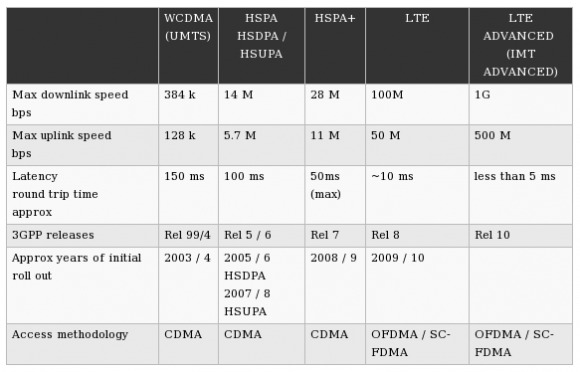4G: What Does This Really Mean?
Texas resident, Keith Geissler, contacted the Better Business Bureau when he found that his ATRIX 4G was only pushing around 300kbps up the tube instead of the expected 5.5mbps.
The ATRIX is a HSUPA-capable device, and we currently are performing the testing and preparations necessary to ensure that, when we turn this feature on, you will continue to have a world class experience.
AT&T hasn't quite gotten their act together as quick as they had hoped with this one. Sometimes the real answer is that these systems are technically the bleeding edge, and it's not some conspiracy to keep you from achieving your top speeds on the wireless internet. Here's a little help discerning the technical specs from behind the marketing malarkey surrounding the wireless broadband available on the market.3G, 4G, LTE, HSPA, WiMax
I could go into a Wikipedia-esque discussion of all of the various mobile data standards since the dawn of mobile data standards, but I'd rather not. I'm going to focus on disambiguation of a few of these key terms and let you know what you really need to know. If you haven't heard of LTE, HSPA, or WiMax before, don't be alarmed. They're just protocols to govern wireless and mobile data transmission. They set standards so that your device can talk to any similarly equipped cellular tower
It makes it easier that these technologies are already cleanly divided along service provider lines. LTE has been deployed in the US by Verizon and MetroPCS. WiMax is the realm of Clearwire and Sprint. AT&TMo are known to use HSPA to provide their broadband. Of course these lines are shifting with the shakeups going on in the market, but that's how things are currently arrayed.
HSUPA
What is HSUPA? Does it make sense that it was turned off? Should we clamor for AT&T's summary execution? HSUPA is a part of the HSPA (High Speed Packet Access) wireless telecommunications protocol. It's the part that lets you upload quickly. The HSUPA (The U stands for Uplink) works along side HSDPA (Downlink) to provide the whole protocol, HSPA. Get it? Really, the fact that this portion of the system was delayed is not really a surprise to anyone who has ever imagined the amount of real infrastructure that goes into producing the end-user-experience we expect. Honestly, whenever a telcom rolls out an upgrade project of this magnitude, it's hilarious if anyone doesn't expect delays in something. HSUPA was where the slack had to be this time, no big deal. Hey, AT&T, just let us know what the deal is before we have to go to the Better Business Bureau.
What's up with all of these G's? How many G's do I need again?
The G designation on all of these various technologies is a generational marker by the International Telecommunications Union (ITU). Most smartphone users are more than happy with their current 3G connection. It allows for mobile e-mail browsing, web-surfing, and some amount of streaming video. I've enjoyed Netflix on my iPhone with no hiccups. With all that the 3G is able to deliver, it's still all about the 4G. Or if you're not into the whole brevity thing, the 4th Generation of Mobile Telephony Standards. None of the technologies available on the market can currently hang with the ITU's 4G requirements. The ITU set "peak speed requirements for 4G service at 100 Megabits per second for high mobility communication (such as from trains and cars) and 1 Gbps for low mobility communication (such as pedestrians and stationary users)."
LTE vs WiMax vs HSPA

WiMax and LTE are standards that come from different organizational origins. WiMax comes from the side of the IEEE, known for bringing you the collection of standards we dub Wi-Fi. This standard Wi-Fi connection is governed by a set of protocols collectively known as 802.11. WiMax is governed by a set of protocols collectively known as 802.16. LTE is a product of the Third Generation Partnership Project (3GPP), spawned from the international GSM standard. "Work on LTE has been going on since 2004, building on the GSM/UMTS family of standards that dates from 1990"
My friend, Robert Evans, recently sang of the death of WiMax. The standard has had a good run of it since they've had NTT DoCoMo of Japan coming after it since 2004. What? You don't remember when NTT DoCoMo called for LTE or Long Term Evolution, to become the international standard for wireless communication? Neither did I. Even with six years in the making, the long term goals of LTE have not yet been made manifest, as the standard is still considered to be a third generation communication technology as it's currently deployed. Full fourth generation wireless transmissions will be coming out this year with specifications like the LTE Advanced.
We will continue to see increased transmission speeds and decreased latency via wireless over the next few years, regardless of the protocol in which the packets are scribed.

Read more about what's going on with your wireless at Android Community.
[via Gadget Lab]
